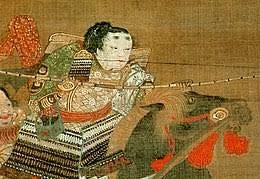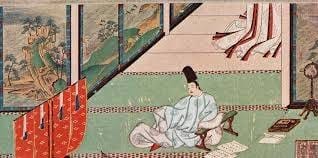Prince Munetaka, the first Imperial Shogun
Conspiracy, scandal, implications, orchestrated overthrows and intrigue in Kamakura
Prince Munetaka
The 6th Kamakura Shogun, Prince Munetaka was born the first son of the de-facto Emperor Go-Saga on December 15, 1242, and was the first Imperial Family member to be appointed as Seii Taishogun (Shogun). As the Kamakura Shogun he held office from 1252 to 1266.
Prince Munetaka was the eldest son of Emperor Go-Saga, and was raised by his father's favorite concubine. In 1244, his half brother, Prince Kuni (later Emperor Go-Fukakusa) was born to a higher ranked mother, and was therefore a contestant to the Imperial throne, yet instead of being sent to a become a monk as was often the case, on the orders of his father, he remained a prince. Emperor Go-Saga was concerned about Munetaka’s future. Before the birth of future Emperor Go-Fukakusa, Munetaka was the most likely candidate to succeed to the throne, and even after that, he was not made to become a monk, instead he remained a “spare heir” in case of an Imperial emergency. In 1247, at the request of Emperor Go-Saga, Munetaka was adopted by the Imperial Princess Rishi (also known as Shikikenmon'in) , who had no descendants, so it was planned that her estates would go to Munetaka as a future lord.
At this time, the shogunate had already established an autocratic system under the control of the powerful Hojo clan. It was the Regent Hojo Tokiyori who considered Munetaka for the role of Shogun, and in securing his father’s approval, orchestrated the ousting of the 5th Shogun, Yoritsugu. In December of 1251, Shogun Yoritsugu was implicated in a plot regarding the Hoji War, (also known as The Hoji conflict, in which the Hojo clan destroyed the rival Miura clan, and consolidated its authority as regents) and in February of the following year, 1252, the shogunate — or to be precise, the Hojo — decided to replace him and appoint the son of Emperor Go-Saga, Prince Munetaka, as the new shogun. The 14-year-old Yoritsugu was dismissed from his position as Shogun, and he and his family, including his grandfather, Kujo Michiie (also suspected of plot involvement) were exiled to Kyoto.
Prince Munetaka was was then proclaimed Shogun by his half-brother, Emperor Go-Fukakusa and taken to Kamakura, the seat of government at the age of 11 in April 1252, and prepared for the role. Role is the correct term to use in such a case, as the shogun was merely a puppet for the true military leaders, the Hojo clan, who as regents, had long controlled the office. His investment was the first time a direct Imperial descendent had held such a military position.
The shogun had no authority. As a result, over the coming years Munetaka devoted himself to composing waka poetry, and held many poetry gatherings. These poetry circles — centered around the samurai and influentials of Kamakura — flourished. They also became catalyst for potential problems, real or imagined.
In June of 1263, it was announced that Prince Munetaka would visit Kyoto as Shogun, and on August 9, the list of vassals accompanying him and the date of departure (October 3) was announced, but on the 25th, the trip was suddenly canceled. Officially, the reason given was due to a natural disaster, but the main reason is thought to be the heavy economic burden placed on the vassals, and in particular the deteriorating health of former regent, Hojo Tokiyori (who died a month later on November 22) along with the “discovery” that Tsuchimikado Akikata, a provisional chief counselor and maternal relative of Emperor Go-Saga, who was in Kamakura, had been conspiring with Prince Munetaka, who still had a chance of succeeding the throne, to plot a coup while in Kyoto.
In 1266, under the advice of his teacher and advisor, the Buddhist priest, Ryoki, Munetaka made moves to free himself from the clutches of the Hojo and obtain full political power for himself and the office of shogun. The plot to oust the Hojo was discovered, and in turn, Munetaka himself was deposed. The details of how Prince Munetaka was dismissed as Shogun remain unclear, but some believe that he was accused of treason and on pretext of a scandal regarding an affair between his wife and a Shogunate guardian.
On June 20th, 1266, a "secret Imperial decision" was made by regent Hojo Masamura, Hojo Tokimune, counsellor and chief priest, Sanetoki, and Adachi Yasumori. That same day, Shogunate guardian and monk Matsudono Sojo Yoshimoto left the palace and fled under accusation of having had an affair with Munetaka’s wife, Konoe Saiko. On the 23rd, Saiko, her daughter Princess Osako and Munetaka’s heir, Prince Koreyasu suddenly entered Hojo Tokimune's residence. This unexplained commotion caused the vassals to gather in Kamakura, and on July 4th, Hojo Noritoki of the Nagoe branch of the Hojo clan led an armed military uprising, ostensibly in support of the Shogun, which Hojo Tokimune stopped, and reprimanded him for his recklessness. That same day, Munetaka was transferred to the residence of Hojo Tokimori, and was sent back to Kyoto on the 8th.
Munetaka’s son, Prince Koreyasu would become the 7th shogun, under the thumb, and ever watchful eye of the Hojo clan.
Prince Munetaka entered Kyoto on the 20th and stayed at the Rokuhara residence of Hojo Tokishige. On the 24th, Koreyasu became the next Shogun in Kamakura. Munetaka was allowed to maintain five territories for his future livelihood, and in accepting, it was made clear that no further charges would be laid against him. Munetaka became a priest and lived out his days in Kyoto writing Waka poetry. The 6th Kamakura Shogun, Prince Munetaka died on September 2, 1274. Aged 31.





